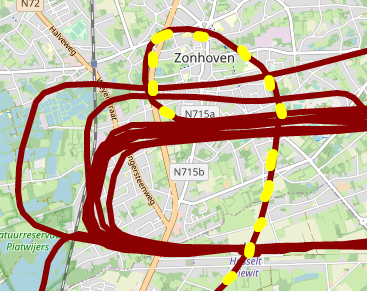I spent an hour flying solo circuits again.
It was a beautiful Saturday so it was more busy on the airfield than I was used to.
I had to pay close attention to other traffic in the circuit. This involves keeping a sharp look-out but also listening to the radio when other pilots announce their location. On top of that, it was important for me to announce my position and intentions to the other pilots.
There were:
- Gliders
- A glider tow plane
- Regular General Aviation
- A helicopter
- Some guls and other birds
EBZH is an uncontrolled airfield. That means pilots announce their positions on the radio, but there is nothing like an air traffic controller. It's mostly pilot to pilot communication and, in my case, my instructor on the ground.
Gliders
Gliders are towed by a tow plane. They use a different, lower and shorter, circuit. This means that when the tow plane enters their circuit, they will be below me, and likely land before me.
The gliders were mostly up in the air. They are usually higher (+ 2000 ft) than I fly (~ 1000 ft). But there were many, I felt like everywhere I looked I could see one.
They usually circle in the sky, in order to stay in an upwards draft. This is how they stay in the air without an engine.
I was mostly not influenced by the activity, except once during landing: all the aircraft are equiped with a FLARM (FLight alARM) device that will give an audible signal and a visual indication of traffic very close by. As traffic gets closer, the alarm gets more pressing.
While I was landing, the glider tow plane was parked right next to the treshold, so the beeping was a bit distracting during the landing. But I understand what the alarm was, so it wasn't really an issue.
A Helicopter in the Circuit
Apart from me, there was another student flying. But they were flying a helicopter.
This is not so different from other traffic. They fly the same circuit.
I assumed a helicopter was quite fast, so I wasn't to worried as I entered the down-wind a little after the helicopter.
But I noticed I was catching up, and during the base-leg I was getting a little worried.
I was trying to decide what to do, and my best idea was to leave the circuit: pull up, announce my intention and leave to the south.
But just at that moment, my instructor adviced me to do a "360 to the left". That is exactly what it sounds like: make a circle on the circuit. This gave the helicopter a chance to land, and after the 360 I entered my final-leg without further complications.

A trip to Hasselt
Because of the number of gliders I saw, I was a little apprehensive of taking a little tour outside of the circuit. But after a few rounds I gathered my courage and announced after take-off: "G83 leaving the circuit to the South".
I flew around Hasselt a bit, keeping my altitude a little low. I then returned for an overhead pass in order to announce I'd be joining the circuit again:
I flew in from South to North, overhead at 1800 ft (+600 ft above the circuit). Announced on the radio: "G83 overhead at thousand eight hundred feet to join circuit".
After passing over the down-wind leg (identified by the tennis court) I decended and circled into the beginning of the down-wind leg.

Flying Solo
Afterwards, I explained to my instructor that when I fly solo, I notice a lot more sounds of the aircraft, and wonder if they are normal. This is a psychological thing, so I know why I hear those things.
He explained you get the same effect when flying over a large body of water.
The landings
Most of my landings were actually quite OK. But I always came in quite high. Luckily I had a head-wind, and setting the flaps to full soon enough allowed me to lose the necessary height.
The Next Flight
For my next flight, I was asked to prepare a navigation: from EBZH to Liernu to Goetsenhoven (EBTN) for a landing and back to EBZH.
GPS Track
Running Costs
1:05 flying time: € 110,50
1 hour instructor time: € 36